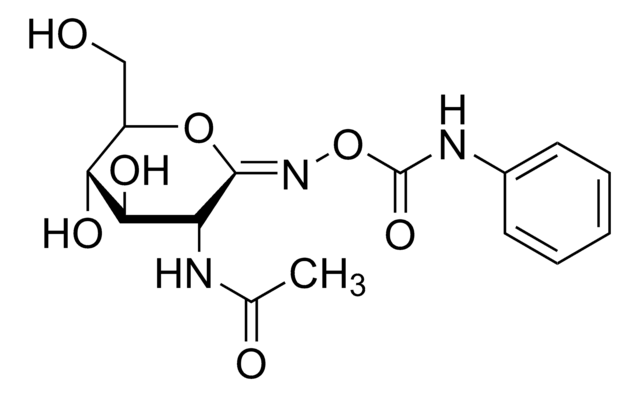MABE1094
Anti-Cdx1 Antibody, clone 123a
clone C, from mouse
Synonym(e):
Homeobox protein CDX-1, Caudal-type homeobox protein 1
About This Item
Empfohlene Produkte
Biologische Quelle
mouse
Qualitätsniveau
Antikörperform
purified immunoglobulin
Antikörper-Produkttyp
primary antibodies
Klon
C, monoclonal
Speziesreaktivität
human
Methode(n)
ChIP: suitable
immunocytochemistry: suitable
western blot: suitable
Isotyp
IgG1κ
NCBI-Hinterlegungsnummer
UniProt-Hinterlegungsnummer
Versandbedingung
wet ice
Posttranslationale Modifikation Target
unmodified
Angaben zum Gen
human ... CDX1(1044)
Allgemeine Beschreibung
Spezifität
Immunogen
Anwendung
Epigenetik & nukleäre Funktionen
Transkriptionsfaktoren
Western Blotting Analysis: A representative lot detected the target band in CDX1-expressing colorectal cancer (CRC) cells (HT55, LS174T, RCM-1, SK-CO-1), but not in non-Cdx1-expressing CRC (DLD-1, HCT116, SW48, RKO) cells (Chan, C.W., et al. (2009). Proc. Natl. Acad. Sci .U. S. A. 106(6):1936-1941).
Western Blotting Analysis: A representative lot detected the endogenously expressed CDX1 in HCT116 human colorectal cancer (CRC) cells. Antibody blocking with the immunogen peptide, but not with a C-terminal peptide, prevented the target band detection (Chan, C.W., et al. (2009). Proc. Natl. Acad. Sci .U. S. A. 106(6):1936-1941).
Immunocytochemistry Analysis: A representative lot detected a downregulated CDX1 immunoreactivity among SW1222 and LS180 colorectal cancer (RC) cell colonies following prolyl-hydrolase inhibitor DMOG (Cat. No. 400091) treatment as a result of enhanced normoxia HIF-α transcription activity (Ashley, N., et al. (2013). Cancer Res. 73(18):5798-5809).
Immunocytochemistry Analysis: A representative lot detected a high expression of the enterocyte differentiation marker CDX1 among colonies formed from colorectal cancer (RC) cells (SW1222, LS180, CCK-81) under normoxia condition, while a much lower Cdx1 immunostaining was seen among the colonies formed under hypoxia condition (Yeung, T.M., et al. (2011). Proc. Natl. Acad. Sci. U. S. A. 108(11):4382-4387).
Immunocytochemistry Analysis: A representative lot immunostained LS174T and CDX1-transfected HCT116 colorectal cancer (CRC) cells. No staining was seen among mock-transfected HCT116 cells or CDX1 shRNA-transfected LS174T cells (Chan, C.W., et al. (2009). Proc. Natl. Acad. Sci. U. S. A. 106(6):1936-1941).
Chromatin Immunoprecipitation ChIP) Analysis: A representative lot detected CDX1 occupancy at the KRT20 promoter site using chromatin preparation from HT55 human colorectal cancer (CRC) cells (Chan, C.W., et al. (2009). Proc. Natl. Acad. Sci. U. S. A. 106(6):1936-1941).
Qualität
Western Blotting Analysis: 1.0 µg/mL of this antibody detected Cdx1 in 10 µg of human Caco-2 colorectal cancer cell lysate.
Zielbeschreibung
Physikalische Form
Lagerung und Haltbarkeit
Sonstige Hinweise
Haftungsausschluss
Sie haben nicht das passende Produkt gefunden?
Probieren Sie unser Produkt-Auswahlhilfe. aus.
Lagerklassenschlüssel
12 - Non Combustible Liquids
WGK
WGK 1
Flammpunkt (°F)
Not applicable
Flammpunkt (°C)
Not applicable
Analysenzertifikate (COA)
Suchen Sie nach Analysenzertifikate (COA), indem Sie die Lot-/Chargennummer des Produkts eingeben. Lot- und Chargennummern sind auf dem Produktetikett hinter den Wörtern ‘Lot’ oder ‘Batch’ (Lot oder Charge) zu finden.
Besitzen Sie dieses Produkt bereits?
In der Dokumentenbibliothek finden Sie die Dokumentation zu den Produkten, die Sie kürzlich erworben haben.
Unser Team von Wissenschaftlern verfügt über Erfahrung in allen Forschungsbereichen einschließlich Life Science, Materialwissenschaften, chemischer Synthese, Chromatographie, Analytik und vielen mehr..
Setzen Sie sich mit dem technischen Dienst in Verbindung.







